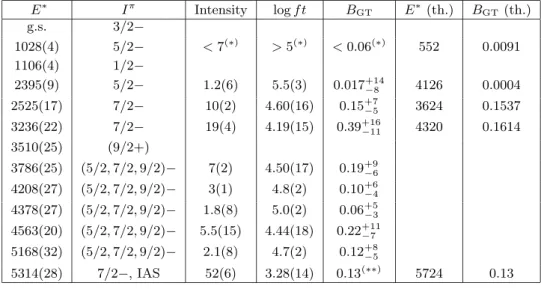DOI: 10.1140/epja/i2006-10-116-7 Eur. Phys. J. A 28, s02, 1 (2006)
EPJ A direct
electronic onlyErratum
Beta decay of
57
Zn
A. Jokinen1,2,a, A. Nieminen1, J. ¨Ayst¨o1,2, R. Borcea3, E. Caurier4, P. Dendooven1, M. Gierlik5, M. G´orska3,
H. Grawe3, M. Hellstr¨om6, M. Karny5, Z. Janas5, R. Kirchner3, M. La Commara3, G. Martinez-Pinedo7, P. Mayet3,
H. Penttil¨a1, A. Plochocki5, M. Rejmund3, E. Roeckl3, M. Sawicka5, C. Schlegel3, K. Schmidt3, and R. Schwengner8
1 University of Jyv¨askyl¨a, Department of Physics, FIN-40351 Jyv¨askyl¨a, Finland 2 CERN, CH-1211 Geneva 23, Switzerland
3 Gesellschaft fr Schwerionenforschung mbH, D-64291, Darmstadt, Germany
4 Institut de Recherches Subatomiques (IN2P3-CNRS-Universit´e Louis Pasteur), F-67037 Strasbourg Cedex 2, France 5 Warsaw University, Institute of Experimental Physics, PL-00681 Warsaw, Poland
6 Lund University, Division of Cosmic and Atomic and Subatomic Physics, S-22100 Lund, Sweden 7 Department of Physics and Astronomy, University of Basel, CH-4056 Basel, Switzerland
8 Institut f¨ur Kern- und Hadronenphysik, Forschungszentrum Rossendorf, D-01314 Dresden, Germany
Original article: EPJdirect A3, 1–11 (2002) DOI 10.1007/s1010502a0003
Received: 7 August 2006 /
Published online: 11 August 2006 – c°Societ`a Italiana di Fisica / Springer-Verlag 2006
We publish herewith the correct table 3 which was wrongly published in the original paper as a repetition of table 2.
Table 3. Adopted states in57Cu and experimental feeding of the states, extracted log f t and BGT values of the57Zn decay in comparison with level-energy and BGTpredictions obtained from shell-model calculations. BGT values predicted for higher 57Cu energies are omitted.
E∗ Iπ Intensity log f t BGT E∗(th.) BGT (th.) g.s. 3/2− 1028(4) 5/2− < 7(∗) > 5(∗) < 0.06(∗) 552 0.0091 1106(4) 1/2− 2395(9) 5/2− 1.2(6) 5.5(3) 0.017+14 −8 4126 0.0004 2525(17) 7/2− 10(2) 4.60(16) 0.15+7 −5 3624 0.1537 3236(22) 7/2− 19(4) 4.19(15) 0.39+16 −11 4320 0.1614 3510(25) (9/2+) 3786(25) (5/2, 7/2, 9/2)− 7(2) 4.50(17) 0.19+9−6 4208(27) (5/2, 7/2, 9/2)− 3(1) 4.8(2) 0.10+6−4 4378(27) (5/2, 7/2, 9/2)− 1.8(8) 5.0(2) 0.06+5−3 4563(20) (5/2, 7/2, 9/2)− 5.5(15) 4.44(18) 0.22+11−7 5168(32) (5/2, 7/2, 9/2)− 2.1(8) 4.7(2) 0.12+8 −5 5314(28) 7/2−, IAS 52(6) 3.28(14) 0.13(∗∗) 5724 0.13
(∗)See discussion in Chapter 3.; (∗∗)Shell-model value.
